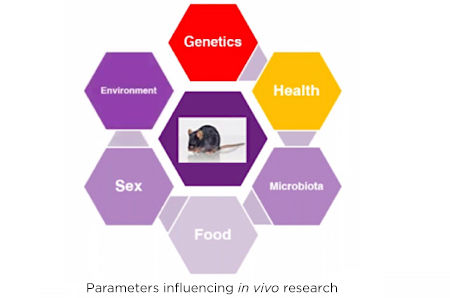 What is genetic quality and how does it impact in vivo research? Dr. Ana Perez addressed this topic in a recent webinar, making the case that research reproducibility requires high genetic quality of laboratory rodents.
What is genetic quality and how does it impact in vivo research? Dr. Ana Perez addressed this topic in a recent webinar, making the case that research reproducibility requires high genetic quality of laboratory rodents.
Genetic Background Categories
In terms of their genetic background, Dr. Perez divided animal models into four basic categories. Each category requires a distinct approach to maintaining genetic integrity:- Inbred strains have a homogenous genetic background and are generated via brother x sister mating for twenty generations. Individual animals in an inbred strain are genetically identical to each other.
- Outbred stocks are populations of individual animals with genetic variation. Outbreds have several advantages, including large and frequent litters and rapid growth. They are commonly used for toxicology studies.
- Transgenic strains and stocks have been made using various technologies, including pronuclear injection, targeted mutations using homologous recombination, and CRISPR/Cas9.
- For pronuclear injection and CRISPR/Cas9, each founder should be considered an independent line. Sequencing of CRISPR founders is strongly recommended to verify the mutation introduced.
- For targeted mutations via homologous recombination, each ES cell clone must be maintained separately.
- Congenic refers to two strains which differ in one marker. For example, the B6 nude strain is congenic on the B6 strain; it differs only in having the Foxn1nu mutation on chromosome 11 compared to the parent B6 strain. Mutations which have been generated or spontaneously appeared on a particular background may need to be moved to a different background. This is done through generation of a congenic strain. A simple approach to generation of a congenic is to backcross the mutation of interest to the desired strain background for ten generations.
How to Preserve Genetic Quality
Dr. Perez discussed how Taconic Biosciences preserves genetic quality for different types of strains and stocks.- Inbreds are refreshed from cryopreserved embryos every five years to prevent genetic drift over time. The line is re-established from a Common Ancestor pair and the genetic profile of the line is characterized. Global colonies are harmonized via sourcing from a single Foundation Colony. Genetic monitoring is used at genetic risk points.
- Outbred stocks are bred so as to maintain genetic diversity among the population. Outbreds are refreshed from cryopreserved embryos every 5-7 years. The genetic profile of each stock has been characterized and may be used for genetic monitoring.
- Taconic uses the Poiley system for breeding of outbreds; each stock has a particular number of breeding groups and a minimum number of cages per group. Global colonies are harmonized and genetic monitoring is used to assure that allelic heterozygosity is maintained in each colony.
How Genetic Background Affects Phenotype
Genetic background can influence phenotype of transgenic models. Dr. Perez showed examples of this effect from the literature.In one example, atherosclerotic lesion size in animals with a particular set of mutations varies quite significantly across a large set of genetic backgrounds tested. Mice of different common strains carrying a Pdcd1 (PD-1) knockout displayed a range of effects, from lupus-like glomerulonephritis and arthritis on the C57BL/6 background to autoimmune dilated cardiomyopathy and gastritis on BALB/c.
While it's certainly not practical to generate mutants on every possible strain background, it's important to remember that effects seen on a single strain background may not tell the whole story.
Monitoring Genetic Background
DNA microsatellites are frequently used for genetic monitoring, but can be difficult to test in a high throughput manner. Single nucleotide polymorphisms (SNPs) are now commonly used for genetic monitoring. They are more stable than microsatellites and can be assayed in a high throughput manner.Taconic has developed several different SNP panels for use in genetic monitoring. In the genome scan SNP panel, more than 1400 SNPs differ between some strains, offering good reliability for strain discrimination. SNP panels can be used to direct accelerated backcrossing (speed congenics).
Inbred Substrain Differences
Just denoting the basic strain name is not enough to understand and maintain a line properly. The C57BL/6 strain has multiple known substrains and they can vary quite a bit in phenotype. For example, the C57BL/6J substrain is known to carry a mutation in the Nnt gene which is associated with impaired glucose homeostasis and reduced insulin secretion. C57BL/6N substrains carry a mutation in the Crb1 gene (Crb1rd8 allele) which causes a mild form of retinal degeneration. Several other genetic variants have been documented in C57BL/6 substrains.Other Considerations
Dr. Perez stressed the importance of careful recordkeeping and cryopreservation. Use of transgenic models on defined genetic backgrounds is important. Use of mutants with mixed backgrounds can cause genetic drift over time, loss of phenotype and results which are not reproducible.A particular consideration with conditional mutations is incomplete excision. While cre-mediated deletion may be very efficient, it is not perfect, so testing for presence of all possible alleles (conditional versus deleted, for example) is very important. Undetected residual conditional alleles can confound experiments. Careful selection of genotyping controls can help avoid this problem.















.jpg)

.jpg)
.jpg)
.jpg)
.jpg)





.jpg)


.jpg)
.jpg)

.jpg)


.jpg)





.jpg)

.jpg)




